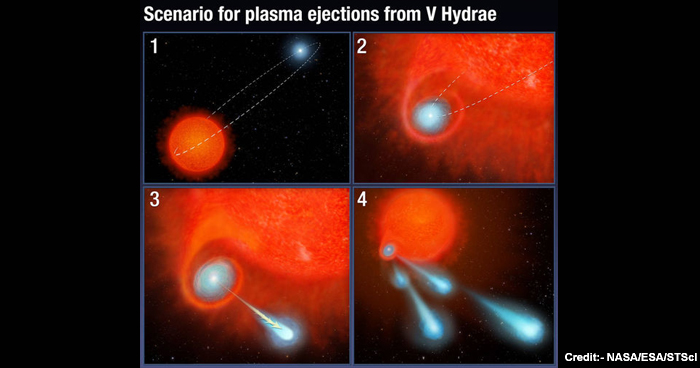
Plasma "Cannonballs" The Size Of Mars Seen Racing From A Mystery Star
NASA's Hubble Space Telescope has detected superhot gas blobs, each twice as massive as the planet Mars, being ejected near a dying star. Plasma balls zoom so fast through space that it would take only 30 minutes for them to travel from Earth to the Moon.
According to the NASA Jet Propulsion Laboratory statement, these fireballs appear every 8.5 years for at least four centuries.
The gas balls were observed near a red giant called V Hydrae, about 1,200 light-years away from Earth. The star is a bloated red giant nearing the end of its fuel supplies and has begun to buffer and expand.
Previously, astronomers had speculated that knotty structures were actually jets of material that emerge from structures called accretion disks, or disks of material that accelerate around a star. While the red giants don't have the accretion disks, the fireballs could not have been ejected from the star.
But the new Hubble data provides researchers with some insight into the strange phenomenon. Suggests that an unseen companion star launched the plasma balls. According to this theory, the companion would have to be in an elliptical orbit close to the red giant's puffed-up atmosphere every 8.5 years. As the companion enters the outer atmosphere of the bloated star, the material is swallowed up. This material then settles into a disk around the companion and serves as a launchpad for plasma blobs, which travel at approximately half a million miles per hour.
This star system could be the archetype to explain a dazzling variety of glowing shapes uncovered by Hubble that are seen around dying stars, called planetary nebulae, researchers said. Planetary nebulae are not like a regular nebula, the birthplace of stars. Instead, they are swirling rings of glowing gas that are expelled by dead or dying stars.
Researchers used the Hubble Space Telescope Imaging Spectrograph (STIS) to conduct observations of V Hydrae and its surrounding area over an 11-year period, first from 2002 to 2004 and then from 2011 to 2013.
Spectroscopy decodes the light from the object, unveiling information about its velocity, temperature, location, and motion.
The data showed a string of monstrous, super-hot blobs, each with a temperature of more than 9.400 degrees Celsius-almost twice as hot as the sun's surface.
The observations showed another surprise: these clumps are not fired in the same direction every 8.5 years, possibly due to waves in the companion's accretion disk.
The study was published in "The Astrophysical Journal."

0 Response to "Plasma "Cannonballs" The Size Of Mars Seen Racing From A Mystery Star"
Post a Comment